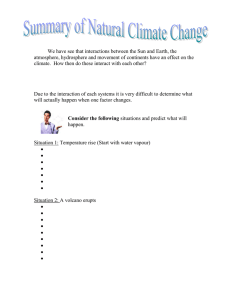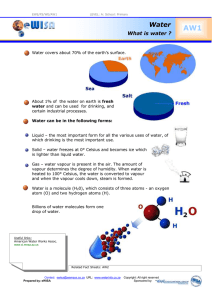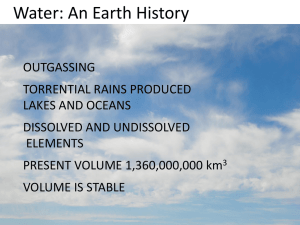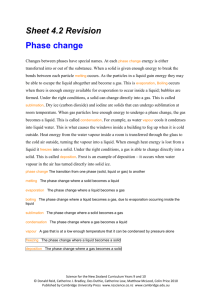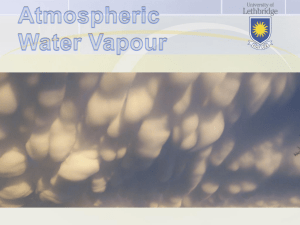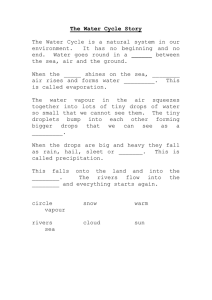Relative humidity
advertisement
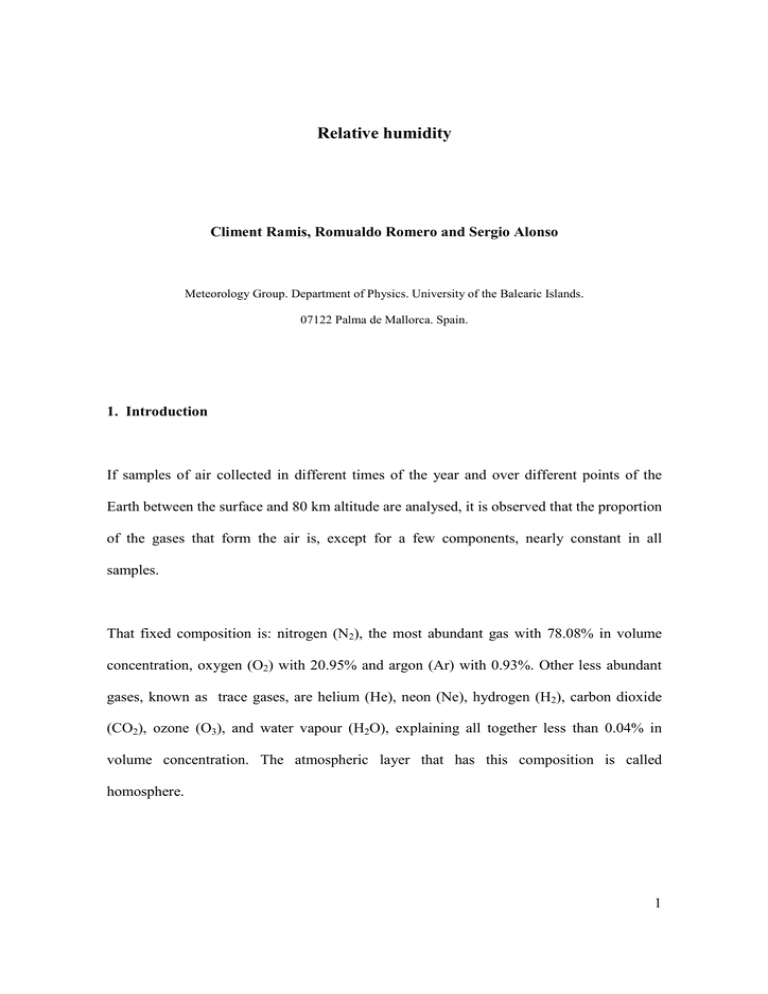
Relative humidity Climent Ramis, Romualdo Romero and Sergio Alonso Meteorology Group. Department of Physics. University of the Balearic Islands. 07122 Palma de Mallorca. Spain. 1. Introduction If samples of air collected in different times of the year and over different points of the Earth between the surface and 80 km altitude are analysed, it is observed that the proportion of the gases that form the air is, except for a few components, nearly constant in all samples. That fixed composition is: nitrogen (N2), the most abundant gas with 78.08% in volume concentration, oxygen (O2) with 20.95% and argon (Ar) with 0.93%. Other less abundant gases, known as trace gases, are helium (He), neon (Ne), hydrogen (H2), carbon dioxide (CO2), ozone (O3), and water vapour (H2O), explaining all together less than 0.04% in volume concentration. The atmospheric layer that has this composition is called homosphere. 1 Among the trace gases, ozone shows a particular vertical distribution. The greater concentrations are found at altitudes between 20 and 35 km. This layer is known as ozonosphere. The concentrations near the Earth surface and over 40 km are very low. On the other hand, ozone concentration is maximum in spring and minimum in autumn in the northern hemisphere. The water vapour distribution exhibits a great spatial and temporal variability. At any given point the quantity of water vapour varies continuously, and it is always different from one place to another. An image from the Meteosat satellite in the water vapour (WV) channel permits to visualize the spatial variability (Fig. 1). This spatial variability is particularly high in the vertical, such that about 75% of the water vapour contained in the atmosphere is found in the lower 3000 m, and practically all this trace gas is trapped in the lowest atmospheric layer or troposphere (10-12 km deep). The high spatial and temporal variability of water vapour requires the definition of variables that, having a simple formulation, permit to quantify its abundance. Water itself is a very important component because it can exist in the three states (solid, liquid and gas) within the atmospheric temperatures range. Many processes occurring in the atmosphere can cause water to change state. Particularly relevant is when water vapour condenses into liquid water, since this process is accompanied by a release of heat that can be absorbed by the air. Similarly, when liquid water freezes or water vapour sublimes latent heat is released. On the contrary, ice melting, ice sublimation and liquid evaporation imply heat absorption. The quantification of water vapour content is therefore some measurement of the latent heat available to the air, which, if released, can strongly affect the atmospheric 2 stability to vertical motions and dynamical processes such as the development of pressure systems. In the remaining of this chapter, some indices that are used to quantify the water vapour content in the atmosphere are described. 2. Vapour pressure and saturation vapour pressure The air is a mixture of gases. The pressure exerted by the air is the sum of the partial pressures exerted by each one of its components (Dalton’s law). The partial pressure exerted by the water vapour, noted as vapour pressure (e), is then a measure of the water vapour content in the atmosphere. A state can be represented by a point in a diagram with coordinates (temperature, vapour pressure)=(T, e). For each temperature a maximum vapour pressure value exists that is known as saturation vapour pressure (es). That saturation value cannot be surpassed, and if water vapour in excess occurs condensation or sublimation is produced. Fig. 2 shows the state curve (T, es), with respect to liquid water for temperatures above 0 ºC and with respect to supercooled water (es) and ice (ei) below 0 ºC. The values for the saturation vapour pressure are determined experimentally. A list of values as a function of temperature can be found in Smithsonian Meteorological Tables (1980). Table 1 includes some es values at several temperatures. 3 Efforts have been carried out to adjust the curve (T, es) with respect liquid water (above and below 0 ºC) by means of an analytic formula. It is emphasized the expression of Tetens (Murray 1967) 7.5t es (t ) =6.11 * 10 t + 237.3 (1) and that of Bolton (1980) 17.67t es (t ) = 6.112 * exp t + 243.5 (2) and the modified Clausius-Clapeyron formula ln es =53.67957- 6473.70 - 4.8451 ln (t + 273.16) t + 273.16 (3) where t is the temperature in ºC and es the saturation vapour pressure in hPa. The Bolton’s expression is precise in a 0.3% in the range –35 ºC to 35 ºC and the modified ClausiusClapeyron method in a 0.01% between –40 ºC and 40 ºC. Both intervals cover a wide spectrum of temperatures in which the condensation phenomena are important. Other more complex formulae for saturation vapour pressure on liquid water and on ice can be obtained through polinomical adjustments (Flatan et al. 1992). 4 Given an air parcel with state (T, e) represented by point O in Fig. 2, two very simple processes would permit the air to reach saturation. Suppose that at constant temperature (t), water vapour is added to the parcel in such a way that vapour pressure is increased. This process would eventually lead to saturation, that is, the vapour pressure would reach es(t) (point C in the diagram). Analogously, the temperature could be diminished while maintaining the water pressure constant and a lower temperature (td) would be reached in which the water pressure would equal the saturation value, that is, es(td)=e (point A). The temperature at which this happens is known as the “dew point temperature”. If the temperature decreased further, the vapour pressure would equally decrease following the curve es while condensation of water vapour would be produced. Another saturation mechanism would consist of adding liquid water to the air parcel. That liquid water would evaporate, getting the necessary heat from the same air. The temperature would diminish at the same time that vapour pressure would increase. Thus, with available enough liquid water, saturation would eventually be reached at some temperature t’ ( point B in Fig. 2). That temperature is known as the “wet bulb temperature” and it is the smallest possible temperature an air mass can acquire by evaporation of water in its body. 5 3. Determination of the vapour pressure The determination of the vapour pressure at surface in the real atmosphere is carried out indirectly by means of the psicrometer. That instrument is composed of two identical thermometers placed in the station screen box, one of which has its bulb dampened in a muslin (Fig. 3), called for that reason the wet thermometer. The temperature difference between the dry thermometer and the humid wet one depends on the water vapour content in the atmosphere; the smaller is the vapour content, the greater is the temperatures difference. Assuming that the air circulating near the humid thermometer effectively reaches the saturation vapour pressure according to the process explained above, its temperature is simply t´ (Fig. 2), while we refer to the dry bulb temperature as t. The following relation is satisfied: e=es (t´)- 8cp p (t − t ') 5 Lv (4) where cp is the specific heat of dry the air at constant pressure, Lv the latent heat of 6 condensation (cp = 1005 Jkg-1K-1, Lv = 2,501 10 J kg-1), and p is the pressure, which permits the determination of vapour pressure e from the dry and wet bulb thermometer readings. Commonly, tables with a double entrance t´ and t-t´ are constructed which permit determination of e (Smithsonian Meteorological Tables, 1980). 6 4. Relative humidity Once a vapour pressure value is determined, the whole picture does not remain complete unless that value is compared against the saturation vapour pressure at the temperature of the air. The relative humidity (h) is thus defined, as the quotient (expressed in percentage) between the vapour pressure e and the saturation vapour pressure es(t) at the corresponding temperature (Wallace and Hobbs, 1977; McIntosh and Thom, 1978): h= 100 e es (t ) (5) Keeping in mind the dew point temperature definition introduced earlier, we have h=100 es (td ) es (t ) (6) and never es(td) can be greater than es(t). For an interpretation see Fig. 2. When h = 100%, saturation has been reached and condensation is produced. Some surfaces exposed to the environment often acquire a temperature that is different to that of the air. For those surfaces an equivalent relative humidity can be defined as: 7 h=100 e es (td ) = 100 es (ts ) es(ts) (7) where ts is now the temperature of the surface. A surface cooler than the air (ts < t), for example, would then promote saturation more easily than the surrounding air. This explains why dew is formed sometimes on plant leaves while a 100% relative humidity has not been reached in the atmosphere. Analogous expressions could be defined considering the saturation pressure with respect to ice. The hygrometers are instruments that measure directly the relative humidity. The digital hygrometers are generally based on some change of the electric properties of some material as function of the relative humidity of the air, whereas the analogic hygrometers use the variation of length that the human hair (especially that of a blond woman!) experiences with a change in the relative humidity. The determination of the dew point temperature, if relative humidity is known, can be carried out by inverting some of the formulae seen before for the calculation of the saturation vapour pressure (expressions (1) to (3)). Conversion tables are also available for that purpose (e.g. Smithsonian Meteorological Tables, 1980). 8 5. Other humidity indices There are several other humidity indexes apart from relative humidity. In fact, they are often more useful than the latter for an adequate formulation of the moist thermodynamic processes that occur in the atmosphere. The following are emphasized: a) Mixing ratio (r) It is defined as the quantity of water vapour per unit mass of dry air. Its units are therefore g g-1 but generally it is expressed in g kg-1: r= mv md (8) Both the water vapour and dry air portions of the sample, which have partial pressures e and p-e, respectively, comply the equation for the ideal gases, then e= mv Rv T V p-e= md Rd T V (9) (10) 9 where Rv and Rd are the specific gas constants of water vapour and dry air, respectively, V the volume and T the temperature. Combining (9) and (10) it is obtained r= mv Rd e e = =ε md Rv p − e p−e (11) and according to the constants Rd = 287.04 J kg-1 K-1 and Rv = 461.50 J kg-1 K-1, expression (11) would be r=0.622 e p−e (12) Within the interval of temperatures and atmospheric pressures, e<<p, and therefore r ≅ 0.622 e p (13) If the vapour pressure corresponds to its saturation value, then a saturation mixing ration is defined rs ≅ 0.622 es p (14) that depends only on pressure and temperature. 10 Using (13) and (14) it is obtained for the relative humidity h= 100 e r ≅ 100 es (t ) rs (t ) (15) Therefore, the numerical values of h deduced from the vapour pressure or from the mixing ratio are practically the same. The exact relation between the relative humidity and the mixing ratio is r h= 100 rs (t ) rs (t ) ε r 1+ ε 1+ (16) b) Specific humidity (q) The specific humidity is defined as the relation between the vapour mass and the mass of moist air that contains this vapour, that is, the quantity of water vapour per unit mass of moist air. q= mv mr + md (17) 11 The units are g g-1 although it is generally expressed in g kg-1 Using the same formulation introduced previously for the mixing ratio q =ε e p − e(1 − ε ) (18) And according to the same previous arguments q≅ε e p (19) and therefore h ≅ 100 q q s (t ) (20) The same comments noted earlier for the mixing ratio (r) are valid for the specific humidity in relation to the relative humidity. The knowledge of the specific humidity permits to calculate the specific parameters for the humid air, e. g., the specific heat 12 c 'p = (1 − q )c p + qcv (22) where cp and cv are the specific heats of the dry air and water vapour at constant pressure, respectively (cp = 1005 J kg-1K-1, cv = 1.85 103 J kg-1K-1 ); and the specific gas constant R ' = (1 − q ) Rd + qRv (23) 13 BIBLIOGRAPHY Bolton, D. (1980) : The computation of equivalent potential temperature. Monthly Weather Review, 108, 1046-1053 Flatan, P. J., R. L. Walks and W. R. Cotton (1992) : Polynomial fits to Saturation Vapour Pressure. Journal of Applied Meteorology, 31, 1507-1513. McIntosh, D. H. and A. S. Thom (1978) : Essentials of Meteorology. Wykeham Publications. Murray, F. W. (1967) : On the computation of saturation vapour pressure. Journal of Applied Meteorology, 6, 203-204. Smithsonian Meteorological Tables, 5th ed., pp. 350 (1980). Wallace J. M. and P. V. Hobbs (1977) : Atmospheric Science. An Introductory Survey. Academic Press. 14 t (ºC) es (hPa) -20 1.2 -10 2.9 0 6.11 10 12.28 20 23.38 30 42.43 40 73.76 50 123.30 Table 1.- Values for the saturation vapour pressure over a plane surface of liquid water at different temperatures. 15 Fig 1.- WV image from Meteosat satellite on 13 November 2002 at 1500 UTC (from Dundee University, UK). Fig 2.- State curve of the saturation vapour pressure as function of temperature. es = pressure over a plane surface of liquid water; ei = pressure over a plane surface of ice. See text for additional information contained in the figure. (diagram based on figure 2.4 of McIntosh and Thom, 1978). Fig, 3.- Psicrometer. Note the wet thermometer, with its bulb covered by a wet muslin. (phogograph courtesy of INM, Spain). 16 Fig. 1 17 Water pressure e es 31.6 hPa C e s (t) B e' = e s (t ') A e = e s (t d ) O 6.1 hPa es ei 0ºC t d t' t 25ºC Temperature Fig. 2 18 Fig. 3 19
